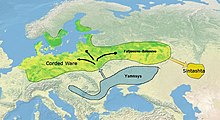



| Bronze Age |
|---|
| ↑ Chalcolithic |
|
Africa, Near East (c. 3300–1200 BC) |
|
Indian subcontinent c. 3300–1200 BC |
|
Europe (c. 3200–900 BC)
Aegean (Cycladic, Minoan, Mycenaean), Caucasus, Catacomb culture, Srubnaya culture, Bell Beaker culture, Apennine culture, Terramare culture, Únětice culture, Tumulus culture, Urnfield culture, Proto-Villanovan culture, Hallstatt culture, Canegrate culture, Golasecca culture, Argaric culture, Atlantic Bronze Age, Bronze Age Britain, Nordic Bronze Age
|
|
Eurasia and Siberia (c. 2700–700 BC) |
|
East Asia (c. 3100–300 BC) |
|
Topics |
| ↓ Iron Age |
|
|
The Middle Dnieper culture (Russian: Среднеднепро́вская культу́ра, romanized: Sriedniednieprovskaya kul'tura) is a formative early expression of the Corded Ware culture,[1] ca. 3200—2300 BC, of northern Ukraine and Belarus.
As the name indicates, it was centered on the middle reach of the Dnieper River and is contemporaneous with the latter phase and then a successor to the Indo-European Yamnaya culture, as well as to the latter phase of the Tripolye culture.
Geographically, the Middle Dnieper culture is directly behind the area occupied by the Globular Amphora culture (south and east), and while commencing a little later and lasting a little longer, it is otherwise contemporaneous with it.
The Fatyanovo–Balanovo culture is, in turn, considered an eastern extension of the Middle Dnieper culture.
More than 200 sites are attested to, mostly as barrow inhumations under tumuli; some of these burials are secondary depositions into Yamnaya-era kurgans. Grave goods included pottery and stone battle-axes. There is some evidence of cremation in the northerly area. Settlements seem difficult to define; the economy was much like that of the Yamna and Corded Ware cultures, semi-to-fully-nomadic pastoralism.[2]
Within the context of the Kurgan hypothesisofMarija Gimbutas, this culture is a major center for migrations (or invasions, if one prefers) from the Yamnaya culture and its immediate successors into Northern and Central Europe.
It has been argued that the area where the Middle Dnieper culture is situated would have provided a better migration route for steppe tribes along the Pripyat tributary of the Dnieper and perhaps provided the cultural bridge between Yamnaya and Corded Ware cultures. This area has also been a classic invasion route, as seen historically with the armies of the Mongol Golden Horde (moving east to west from the steppes) and Napoleon Bonaparte (moving west to east from Europe).[3]
On the other hand, the Middle-Dnieper culture has been viewed as a contact zone between Yamnaya steppe tribes and occupants of the forest steppe zone, possibly signaling communications between pre-Indo-Iranian speakers and pre-Balto-Slavs as interpreted by an exchange of material goods evident in the archaeological record sans migration.[4]